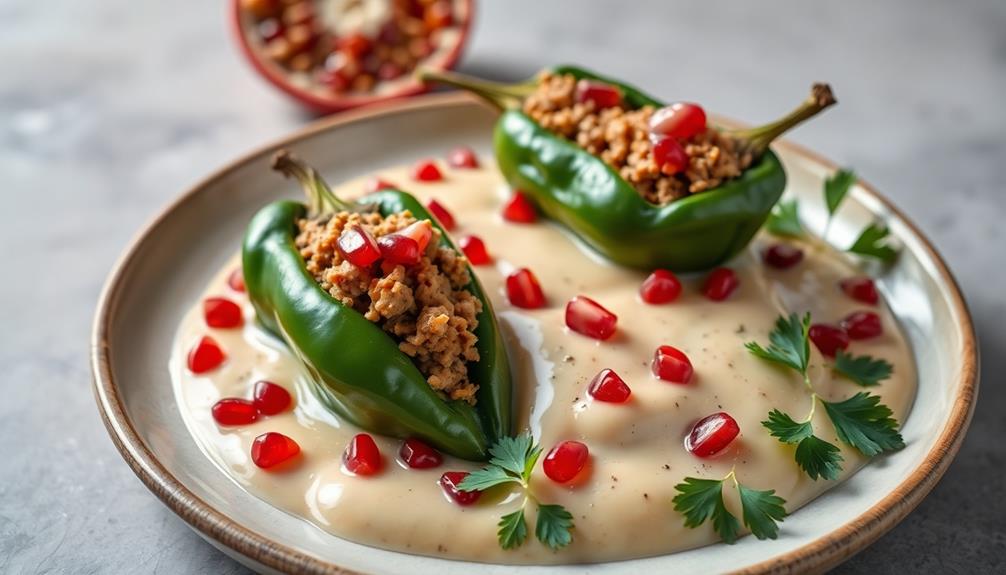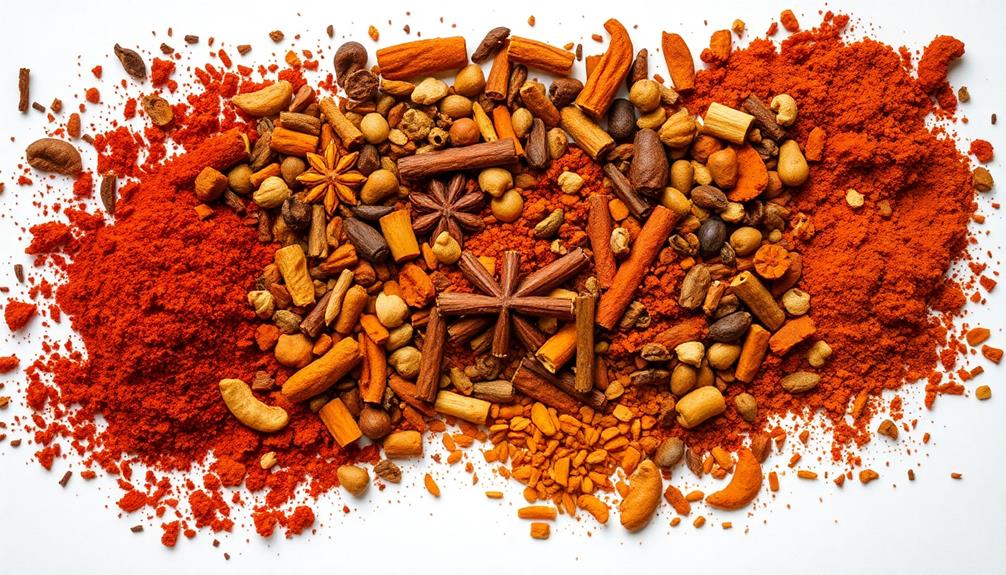Doro Wat is the spicy and aromatic chicken stew that's deeply rooted in Ethiopian culture. For centuries, this dish has symbolized hospitality and community during celebrations. The rich flavor comes from an aromatic blend of spices, especially the fiery berbere. You'll typically find it served with injera flatbread or fluffy rice. To make it, you'll sauté onions and garlic, add the berbere and tomato paste, then simmer the chicken until tender. Garnish with hard-boiled eggs and fresh herbs for a beautiful presentation. Doro Wat is a cultural delight that brings people together – let's explore its fascinating history and recipes further.
Key Takeaways
- Doro Wat is a traditional Ethiopian chicken stew known for its rich flavors and complex spice profile, particularly the fiery berbere spice mix.
- The dish is deeply rooted in Ethiopian culture and traditions, frequently served during special occasions and holidays to symbolize hospitality and community.
- The recipe is passed down through generations, often with unique family twists, and is renowned globally for its distinctive taste.
- Doro Wat is typically served with injera, a traditional Ethiopian flatbread, or fluffy rice, and is commonly garnished with hard-boiled eggs and fresh herbs.
- Experimentation with spices and patience during cooking are essential for developing the depth of flavor in Doro Wat, making it a communal dish enjoyed by family and friends.
History
The origins of doro wat, a popular Ethiopian stew, can be traced back centuries. This vibrant, spicy dish has long been a staple in Ethiopian cuisine, with roots that stretch deep into the country's rich cultural heritage.
In traditional celebrations and gatherings, doro wat holds a revered place, often taking center stage as a symbol of hospitality and community.
The recipe for this iconic stew has been passed down through generations, each family adding their own unique twist to the blend of aromatic spices and tender chicken. Some recipes call for the addition of hearty root vegetables like carrots and potatoes, while others may opt for a more robust kick of heat with the inclusion of chili peppers. Whichever version you try, one thing is for sure: this spiced raw beef recipe is sure to warm you up on a chilly night and leave you feeling nourished and satisfied. As each family continues to adapt and perfect their own version of the stew, the tradition of sharing and celebrating good food remains the heart of this cherished dish.
The key ingredient, the fiery berbere spice mix, lends doro wat its signature bold flavor, infusing the dish with a complex heat that tantalizes the palate.
As you savor each bite, you'll be transported to the bustling marketplaces and lively festivals of Ethiopia, where the aroma of doro wat fills the air and brings people together around the table.
Recipe
Doro Wat is a traditional and beloved Ethiopian chicken stew, renowned for its rich, complex flavors and vibrant red color. This dish is a staple in Ethiopian cuisine and is often served during celebrations and special occasions. The key to a truly exceptional Doro Wat lies in the meticulous preparation of the spices and the long, slow simmering that allows the flavors to meld and deepen.
The heart of Doro Wat is the berbere spice blend, a unique and essential ingredient that imparts the dish with its signature flavor profile. This blend of spices, including chili peppers, garlic, ginger, and a variety of aromatic seeds and herbs, is the foundation upon which the entire dish is built.
Ingredients:
- 2 lbs boneless, skinless chicken thighs, cut into 1-inch pieces
- 1 large onion, finely chopped
- 4 cloves garlic, minced
- 1 tablespoon grated ginger
- 1/4 cup berbere spice blend
- 1 cup chicken broth
- 1/2 cup tomato paste
- 2 hard-boiled eggs, peeled and halved (optional)
- Salt and pepper to taste
Instructions:
In a large pot or Dutch oven, sauté the onions in a small amount of oil over medium heat until they're soft and translucent.
Add the garlic and ginger, and cook for an additional minute, stirring constantly to prevent burning.
Stir in the berbere spice blend and let it toast for 2-3 minutes, until fragrant.
Gradually pour in the chicken broth, whisking continuously to prevent any lumps.
Add the tomato paste and stir to combine.
Add the chicken pieces, cover the pot, and simmer on low heat for 45-60 minutes, or until the chicken is tender and the sauce has thickened.
When serving, garnish the Doro Wat with the hard-boiled egg halves, if desired.
The long, slow cooking process is crucial for developing the complex flavors of this dish, so be patient and let the stew simmer until the chicken is fall-off-the-bone tender.
Serve the Doro Wat with injera, the traditional Ethiopian flatbread, for a truly authentic experience.
Cooking Steps
Chop the onions into small, even pieces.
Next, add the minced garlic and berbere spice, stirring everything together.
Then, incorporate the tomato paste and chicken, simmering the mixture until the chicken is cooked through.
Step 1. Chop Onions Into Small Pieces
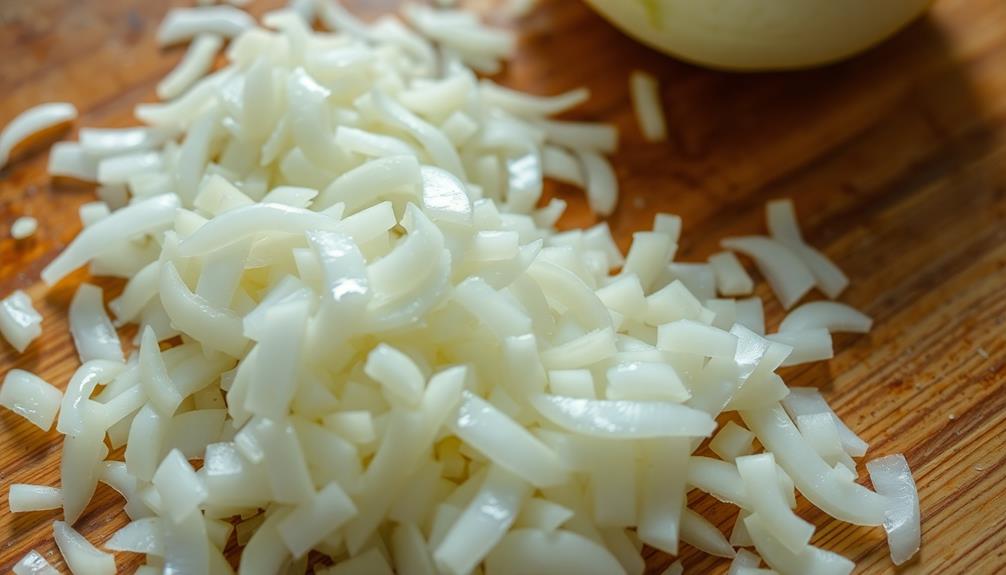
To begin, you'll want to carefully chop the onions into small, uniform pieces. Start by slicing the onions in half from the root end to the stem end.
Lay the halves flat on the cutting board and thinly slice them, moving the knife back and forth in a rocking motion. Next, take those sliced onion pieces and dice them, cutting across the slices to create small, evenly-sized cubes.
Be sure to keep your fingers curled under as you chop to protect your fingertips. The key is to aim for pieces that are around 1/4 to 1/2 inch in size. This will help the onions cook down quickly and evenly in the stew.
You'll need about 1 large onion or 2 medium onions, chopped, to get the 1 cup of diced onion called for in the recipe. Work carefully and take your time to achieve those perfectly-sized onion pieces.
With a little practice, you'll be chopping onions like a pro in no time!
Step 2. Add Minced Garlic
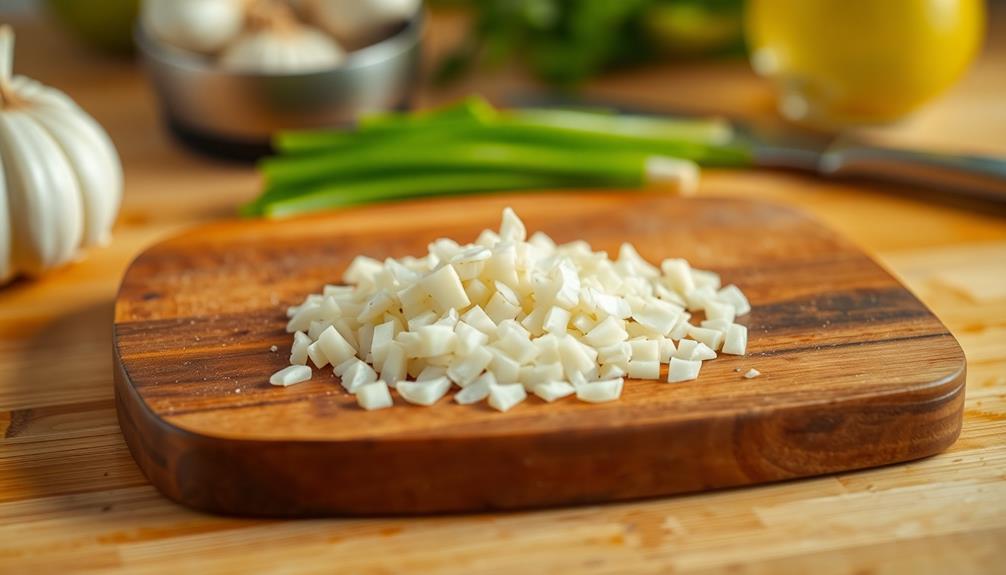
Next, mince the garlic cloves. Use a sharp knife or a garlic press to finely chop the garlic into small pieces. The more minced the garlic, the more it will infuse the stew with its aromatic flavor. Aim for about 3-4 cloves of garlic, or adjust the amount to your taste preferences.
Once the garlic is prepared, it's time to add it to the onions in the pot. Carefully drop the minced garlic into the simmering onions and stir everything together. The garlic will sizzle and release its fragrant oils, blending seamlessly with the cooked onions.
Let the mixture cook for 1-2 minutes, stirring frequently, until the garlic becomes fragrant and softened.
This garlic-infused onion base will provide a flavorful foundation for the rest of the doro wat ingredients. The garlic's pungent notes will complement the warming spices and create a depth of flavor in the final stew.
Be sure to taste and adjust the seasoning as needed before moving on to the next step.
Step 3. Add Berbere Spice
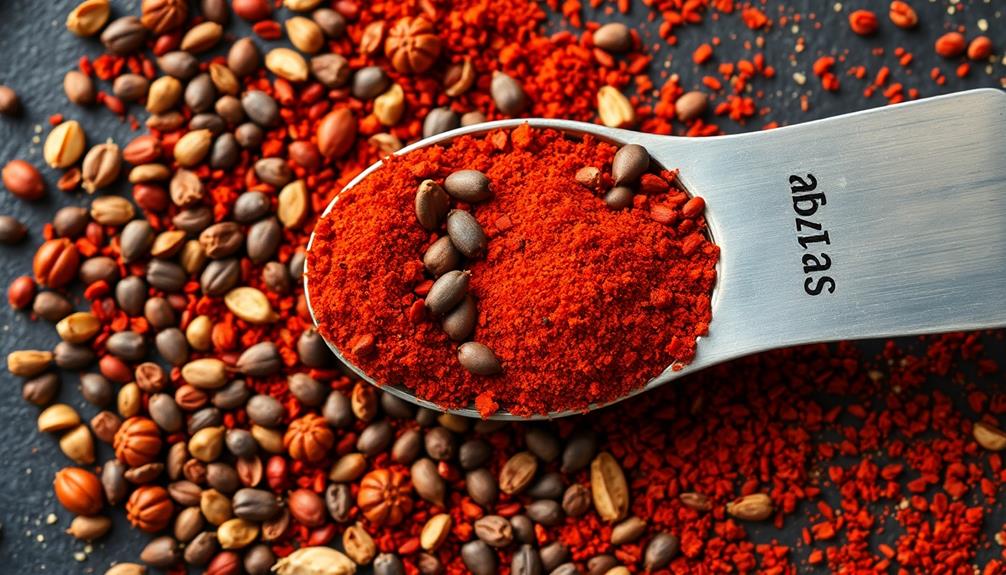
With the aromatic garlic now incorporated, it's time to add the signature spice blend that defines doro wat – berbere. This complex and fragrant spice mix is the heart and soul of this beloved Ethiopian dish.
Begin by measuring out two tablespoons of the berbere spice. Slowly sprinkle it into the simmering pot, stirring continuously to ensure even distribution. The berbere will immediately transform the stew, infusing it with a deep, earthy aroma and a vibrant, fiery hue.
As the berbere blends in, you'll notice the flavors intensify and meld together. The blend of chili peppers, fenugreek, cumin, ginger, and other spices creates a truly unique taste experience.
Be sure to let the berbere cook for about 5 minutes, allowing the flavors to develop and the stew to thicken slightly. The result will be a richly spiced, complex sauce that coats the tender chicken perfectly.
Get ready for your taste buds to be dazzled by the bold, memorable flavors of the berbere spice.
Step 4. Add Tomato Paste
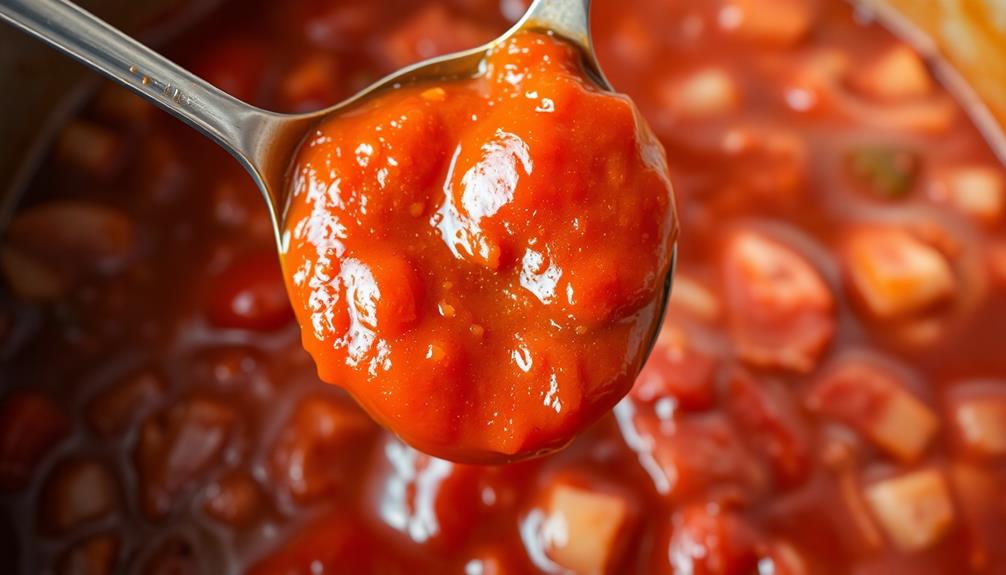
With the robust flavors of the berbere spice now infusing the stew, it's time to add the next key ingredient – tomato paste.
Grab a spoonful of the thick, rich tomato paste and stir it into the bubbling pot. Watch as the paste dissolves, turning the stew a deep, reddish-brown hue.
The tomato paste not only enhances the color, but it also adds a touch of sweetness and acidity, balancing out the heat of the berbere.
Stir the mixture thoroughly, making sure the paste is fully incorporated. Let the stew simmer for a few more minutes, allowing the flavors to meld together.
The addition of tomato paste is crucial, as it helps to thicken the stew and create a velvety, mouth-watering texture.
Be generous with the amount you add, as the tomato flavor will complement the other spices perfectly.
With this final step, your Doro Wat is well on its way to becoming a flavorful and authentic Ethiopian dish.
Step 5. Add Chicken and Simmer

Once the tomato paste has blended into the stew, it's time to add the chicken.
Grab your pieces of chicken and carefully lower them into the simmering pot. You want the chicken to be fully submerged in the aromatic sauce. Let the chicken cook for about 30 minutes, turning occasionally, until it's cooked through and tender.
As the chicken simmers, the flavors will meld together, creating a rich and delicious stew.
Keep an eye on the pot, adjusting the heat as needed to maintain a gentle simmer. The chicken will release its juices, further enhancing the flavor of the dish.
Once the chicken is cooked, use a pair of tongs or a slotted spoon to transfer the pieces to a plate.
Serve the doro wat hot, garnished with fresh parsley or cilantro, if desired.
Enjoy this flavorful and nourishing stew with injera bread or over a bed of fluffy rice.
Final Thoughts
Doro wat, the renowned Ethiopian spiced stew, has captured the hearts and palates of food enthusiasts worldwide. As you've seen, the process of creating this flavorful dish is both rewarding and straightforward. From the aromatic blend of spices to the tender, succulent chicken, each step contributes to the overall complexity and depth of flavor.
While this recipe may seem intimidating at first, with a little patience and the right ingredients, you'll be whipping up authentic doro wat in no time. Don't be afraid to experiment and adjust the seasoning to suit your personal preferences. The beauty of this dish lies in its adaptability, allowing you to make it your own.
As you savor the final product, take a moment to appreciate the rich history and cultural significance of doro wat. This beloved stew isn't just a meal, but a celebration of Ethiopian culinary traditions.
Embrace the experience, share it with loved ones, and let the flavors transport you to the vibrant streets of Addis Ababa.
Frequently Asked Questions
Is Doro Wat Gluten-Free?
Yes, doro wat can be gluten-free. It doesn't contain any wheat-based ingredients, so you can enjoy this flavorful dish without worrying about gluten. Just be sure to check the specific recipe or preparation method.
How Long Does Doro Wat Last in the Fridge?
Homemade doro wat can typically last 3-4 days in the refrigerator when stored properly in an airtight container. The exact shelf life may vary depending on the ingredients and preparation methods used, but it's generally safe to consume within that timeframe.
Can I Use Chicken Thighs Instead of Drumsticks?
You can definitely use chicken thighs instead of drumsticks. The meat from chicken thighs is darker, richer, and more flavorful, making it a great substitute for this dish. Just adjust the cooking time accordingly.
Is Doro Wat Spicier Than Other Ethiopian Stews?
Yes, doro wat is generally spicier than other Ethiopian stews. The blend of berbere spice, ginger, and other seasonings creates a bold, fiery flavor that sets it apart from milder regional dishes.
What Side Dishes Pair Well With Doro Wat?
When serving a spicy stew, you'll want to balance the heat with some cooling and textural contrasts. Consider pairing it with injera, a spongy flatbread, as well as side dishes like shiro (chickpea stew) or gomen (collard greens).

